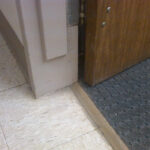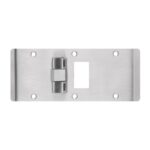Last month I posted an article by Kenneth T. Lumb about the liability that schools carry with regard to non-impact-resistant wired glass. I received a comment from former Oregon State Senator Vicki Walker, who has been an instrumental and passionate force in removing traditional wired glass from Oregon schools. With her permission, I have posted her comment below (or click here to download a PDF version).
Nice article, Mr. Lumb! You hit all the high points, including the actions by the CPSC that led to the explosion of the use of wired glass in architectural applications. You are correct that in 1977 the CPSC issued 16 CFR 1201.1(c) (1) that provided for the limited wired glass exemption. Unfortunately, the limitation was large enough to drive a truck through it, and no one from the agency enforced the limitation. Combined with the fact that the wired glass industry made sure they had several seats at the table on all the regulatory bodies, it is no wonder that true safety glass applications were never allowed to develop to be cost-competitive. Wired glass sold cheap, and the manufacturers knew their product was not safe for use in any application with exposure to human impact because it never met impact standards in any legitimate testing. The overseas wired glass cartel continued to market this stuff as safety glass because they made a lot of money and they had no one watching the hen house. American companies who had true safety glass products were simply shut out of the market. The 1960s, ‘70s and ‘80s saw record construction growth, particularly in new school construction. Every single one of those schools represented a bonus paycheck to the cartel. Every gymnasium, every hospital, every recreation center was filled with this “fake” safety glass that did anything but protect our children.
Thankfully, through Mr. Abel’s tough research and persistence, and my own tenacity, in 2003 we succeeded in changing the Oregon Structural Specialty Code to eliminate the use of wired glass in hazardous locations subject to human impact in all educational facilities, gymnasiums, athletic facilities, and commercial structures in the state of Oregon. No other state in the country had made that step, and a year later Oregon extended the limitation to all building uses in conjunction with the adoption of the updated Oregon Building Code. Unfortunately, the new code was not retroactive to existing locations of wired glass other than requiring replacement glass to meet the new standard. As you noted, we took our fight to the ICC and won new code provisions in 2003 and those were extended further in 2006. Any state adopting the new ICC code provisions would then be subject to the new regulations. It was an important victory, but much work lies ahead.
As you aptly pointed out, none of these code provisions are retroactive. Until schools around the country realize they are paying out more in claims than it would cost to change out existing applications of wired glass, the time bomb will continue to tick. CPSC surveillance data was never specifically coded for wired glass injuries, so it made it difficult to do follow-back studies and determine which glass injuries being presented in hospitalizations and physician visits were related to wired glass. If schools across the country were required to report such data to their state departments of education and their state health departments, insurance carriers and parents will start to take notice and you may see some efforts at addressing these retroactive applications.
The largest of our local school districts in our community changed out their wired several years ago when Oregon adopted the new building codes because the school boards and administrators put the safety of the children in their care at the top of their agenda, no matter what the cost. These are difficult choices because school districts are facing budget cuts all across the country, but one injured child is one too many, in my humble opinion. Our local districts had seen wired glass injuries to students in the past, and it was a sight that one teacher told me he would never forget because it was such a traumatic injury. I testified in a court case in 2011 where a jury found a large school district in Oregon (one that refused to invest in changing out the old glass) was at fault and liable for several thousand dollars to a young student injured by an existing application of wired glass. Injuries and payments like these will continue to plague districts until they address this ticking time bomb.
It’s too bad the wired glass cartel could not be forced to dig into their own pockets to assist school districts in their efforts to bring schools up to safety standards. After all, their desire to make money at the expense of human safety is what got us here in the first place.
For more articles featuring Oregon State Senator Vicki Walker:
• Oregon Building Codes Division Bans Wired Glass
• Wired Glass Industry to Face Investigation and Review by Federal Regulators
• Senator Walker and Advocates Defeat Use Of Wired Glass
• Advocates File Legal Action Against Consumer Product Safety Commission
Posted with permission from Safe Glass Consulting. © 2013 All content is the sole property of Safe Glass Consulting and
may not be reproduced, published or distributed without the express written consent of Safe Glass Consulting, all rights reserved.
You need to login or register to bookmark/favorite this content.






Leave A Comment